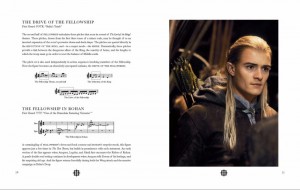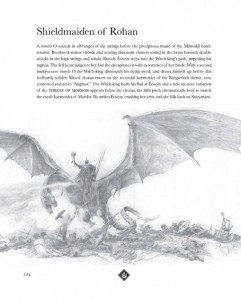 “The Music of the Lord of the Rings Films,” by Doug Adams, Carpetier, $59.95
“The Music of the Lord of the Rings Films,” by Doug Adams, Carpetier, $59.95
It speaks to the longevity of the “Lord of the Rings,” films that ten years later, movie tie-in books are still being released. It speaks to the power of Howard Shore’s soundtrack and author Doug Adams presentation that “The Music of the Lord of the Rings Films,” is the best of LOTR movie-related book and worth the wait.
In fact, if you are still hanging on to some of your post-Christmas or other holiday gift money, this comprehensive account of Shore’s scores are your answer on how to spend. This volume is a must-own for fans of Peter Jackson’s trio of films adapting the works of J.R.R. Tolkien and film score fans.
Tolkien deserves more than a passing mention here because it is clear from Adams’ work that the written word played an important part in Shore’s process. Far beyond scoring a movie, the composer delved into Middle-earth’s history and cultures, creatures and characters in order to best service the film. The book helps elucidate the fact that Shore’s 10-plus hours of music were done with Tolkien in mind as much as Jackson and that Shore’s work stands alone as a musical interpretation of a work of fiction as well as one aspect of the films.
 The book, beautifully arranged in its own right with text, images from the films, illustrations by Alan Lee and John Howe (some for the first time in print) and bits of the score is definitely worthy of display. It features an all-white dust jacket, covering a black binding with gold lettering. It is hefty and rewarding to thumb through and of course much better to spend more extensive time with.
The book, beautifully arranged in its own right with text, images from the films, illustrations by Alan Lee and John Howe (some for the first time in print) and bits of the score is definitely worthy of display. It features an all-white dust jacket, covering a black binding with gold lettering. It is hefty and rewarding to thumb through and of course much better to spend more extensive time with.
It includes a CD in the back cover with unreleased rarities from Shore’s catalog of work on the films. They are presented in the order of the plot-narrative and are a welcome bonus complete with Adams interviewing shore for a few minutes. Some completests wwill no doubt want the book just for these 21 unreleased songs. Reading about music is a wonderful thing but hearing it elevates the experience and the gems found here are enriching and even fun.
Adams accepted the challenge of writing a book intended to sell to the mass of film fans without speaking either down to his audience or going over its head. A book such as this one must address music and composition in the jargon of the art. The language used to discuss music may not be effortlessly understood by those who haven’t studied at least basic musical concepts. Wisely, same-page footnotes were included to clarify terms that precisely apply but aren’t standard vocabulary to your average Frodo-on-the-street. That isn’t to say that a reader with no interest in music will love the book, but those willing to meet the author halfway will find a text that pulls the reader along without shortchanging the loremasters.
So besides informing readers about the process and techniques behind the LOTR soundtrack, they may actually grasp some larger understanding of music. While that cannot be the mission of this volume, the side effect may serve parents as a teaching tool for kids or readers for whom these films serve as a gateway into music literacy.
 The book is also intended for film-score fans and on that level it sets a standard that will be hard to match for any future works like this one. While that group may not need any of the footnotes, there is plenty of information here for those seeking depth and understanding on the process, technique and art employed a decade ago. It features score examples or segments to demonstrate what Adams’ text.
The book is also intended for film-score fans and on that level it sets a standard that will be hard to match for any future works like this one. While that group may not need any of the footnotes, there is plenty of information here for those seeking depth and understanding on the process, technique and art employed a decade ago. It features score examples or segments to demonstrate what Adams’ text.
The book, at a hefty 400 pages, is ambitiously tackling ten hours of music that is at least as epic as the films it was made for. Shore has won many awards for these films but its the unique connection of three-films-as-one that makes the book and the topic extra challenging and rewarding to explore with this kind of depth.
A good chunk of the book is dedicated, appropriately, to exploring musical themes, mirroring Shore’s approach to cultures and environments in the film. Even those who have listened with the sharpest of ears will find their understanding enlarged by Adams’ presentation that makes clear how thematic color and emotions are carried, changed and abandoned during the course of scenes and each individual film as well as the trilogy as a whole.
Reading will make movie viewers more aware of how emotions are being pushed and pulled by director and composer and will leave previously impressed viewers marveling all the more with increased clarity of why not only the score but the films worked on an emotional and technical level for viewers.
The analysis doesn’t beat the joy out of the triumph or drain the despair out of the harrowing and musically-chaotic sections; rather the revelation of the “hows” deepens appreciation of the skill and sometimes delicate, sometimes explosive work.
 Next comes the annotated score, which travels with the reader and the music on the journey inspired by Tolkien’s own Middle-earth. This likewise will be fun and surprising for fans of the films and informative for those steeped in movie music.
Next comes the annotated score, which travels with the reader and the music on the journey inspired by Tolkien’s own Middle-earth. This likewise will be fun and surprising for fans of the films and informative for those steeped in movie music.
Finally, thirty pages are devoted to the recording sessions for the films and include charts and maps and photos of the participants. The musicians and vocalists working under and with Shore are given their due along with sound technicians and all the rest who contributed to the sound and emotion of the films.
The tendency, when reviewing a book like this, is to fear over praising it. Critics throw around words like “magnificent” or “masterpiece” or “landmark” and writers don’t want to be caught in the trap of hyperbolic hallelujahs. There will be readers somewhere that expect anything related to Jackson’s films to have the scent and essence of Elijah Wood and Orlando Bloom contained in its pages and will reject anything less. But to honest admirers of the trilogy and to cerebral readers and delicate listeners, the book is a feast that shines light and delivers knowledge on a topic many think they already know. After careful reading that may include listening with a brand new ear, fans will find we had only a passing acquaintance with Shore’s masterpiece and this volume is the key to a deeper love affair. If things are as they should be, the author will prepare a similar text detailing how Shore ties in the future Hobbit films’ music.
Adams, with this book, sets a standard for film books, fan-friendly publications and music scoring aficionados all at once. It succeeds on every level and can rightly claim the labels of “magnificent,” “masterpiece,” and “landmark” without any pretense. It will remain relevant and appreciated as a companion to the films and the score and Tolkien’s original work as long as they remain.
(Author’s note: Due to my error, this review didn’t appear on TheOneRing.net when planned and the oversight was just discovered. Minor revisions have been made and the author apologizes to fans, the writer and the publisher. I regret the error but it did not in any way influence my review.)


